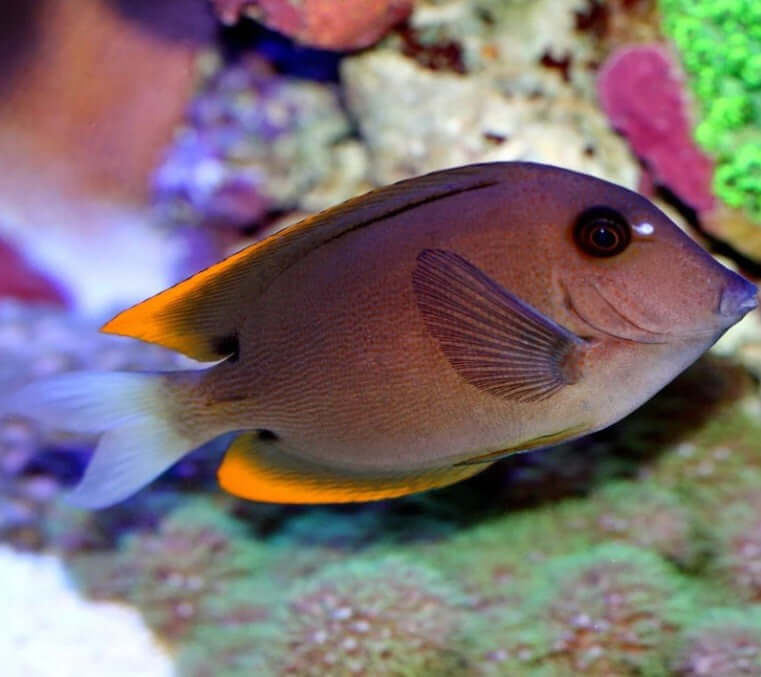|
View Marine Fish Compatibility Chart
Ctenochaetus Tominiensis
The Flame Fin Tomini Tang, scientifically known as Ctenochaetus tominiensis, is a stunning and graceful fish species that belongs to the Acanthuridae family. This marine beauty is highly regarded for its vibrant coloration, sleek body shape, and peaceful nature, making it a popular choice for reef or marine aquarium enthusiasts.
Originating from the Indo-Pacific region, particularly found in the coral reefs of the Western Pacific Ocean, the Flame Fin Tomini Tang showcases a striking combination of colors. Its body is elongated and laterally compressed, with a sleek profile, a pointed snout, and small, sharp spines along its caudal peduncle.
This species typically reaches an average length of around 5-6 inches (12-15 cm) when fully grown. Its body is predominantly covered in a vibrant yellow to orange coloration, resembling the warm hues of a flickering flame. The edges of its fins, including the dorsal and anal fins, are adorned with contrasting blue or purple accents, adding to its overall visual appeal.
One of the distinguishing features of the Flame Fin Tomini Tang is its peaceful temperament. It is generally considered reef-safe and can be kept in a well-established reef or marine aquarium. It should be provided with plenty of swimming space, hiding spots, and live rock for grazing and exploration.
When it comes to feeding, the Flame Fin Tomini Tang is primarily herbivorous, feeding on a diet of algae and other plant matter in the wild. In a home aquarium, it should be provided with a varied diet consisting of high-quality marine-based foods, such as dried seaweed, spirulina flakes, and other herbivore preparations. Supplementing its diet with occasional meaty foods, like brine shrimp or mysis shrimp, can also be beneficial for its overall health.
Maintaining optimal water conditions is crucial for the well-being of the Flame Fin Tomini Tang. It prefers a well-maintained aquarium with stable water parameters, including a temperature range of 72-78°F (22-26°C) and a pH level of 8.1-8.4. Regular water changes and the use of a good filtration system are essential to maintain water quality.
While the Flame Fin Tomini Tang is generally peaceful, it may exhibit territorial behavior towards other tangs or similarly shaped fish species. Care should be taken when selecting tankmates to ensure compatibility and to provide ample swimming and territorial space, especially in larger aquariums.
Overall, the Flame Fin Tomini Tang is a captivating and highly desirable addition to reef or marine aquariums. Its vibrant coloration, sleek body shape, and peaceful nature make it a standout species that adds beauty and tranquility to your underwater world. With proper care, a suitable environment, and a well-balanced diet, the Flame Fin Tomini Tang can thrive and become a mesmerizing centerpiece in your aquatic display.
Use caution when housing with other Tangs or Surgeonfish. Similar shaped Tangs can be very aggressive towards each other. Tangs require a natural diet of seaweed and algae, which can be fed to them tied to a rock or by use of a veggie clip. This should be a done a minimum of 3 times a week. Tangs will also enjoy meaty foods with the other fish in your aquarium.
It is well known that tangs have a penchant for Marine Ich and other diseases due to their lack of slime coating. We highly encourage quarantining all fish, but especially Surgeon Fish. We do our best to quarantine all fish at Reef Chasers but there can be absolutely no guarantees.
Tang's of different species can typically get along if they are given ample living space and given that they are introduced at the appropriate size & time.
|

